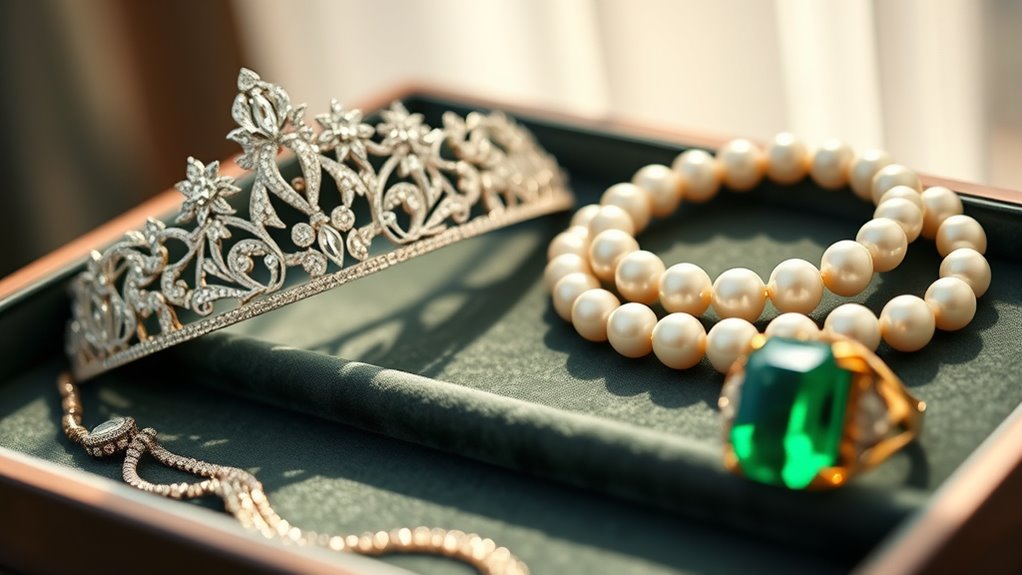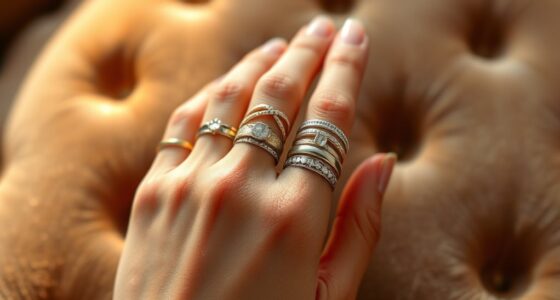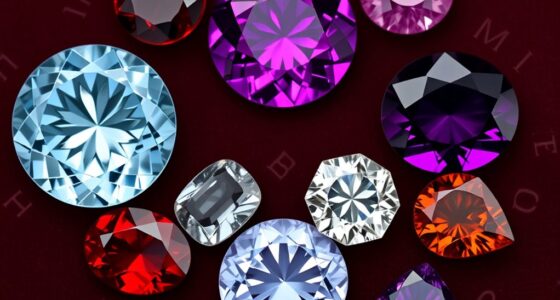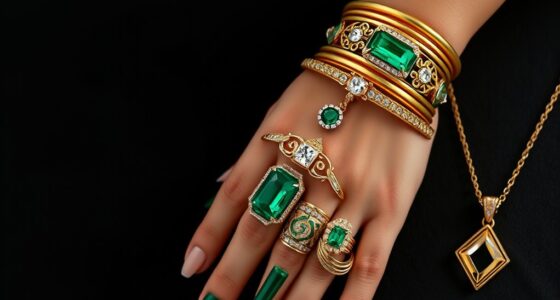Explore iconic jewelry pieces that defined eras, from the mesmerizing Hope Diamond with its royal and tragic history, to Queen Victoria’s elegant mourning jewelry capturing grief and remembrance. Discover the bold Art Deco Cartier Tutti Frutti collection blending vibrant gemstones and cultural influences, and Marilyn Monroe’s legendary pearl necklace symbolizing Hollywood glamour. finally, learn how the royal scepter and crown jewels embody sovereignty and tradition. Keep exploring to uncover the fascinating stories behind these timeless symbols.
Key Takeaways
- The Hope Diamond exemplifies the allure of royal, mysterious gemstones shaping centuries of jewelry history.
- Queen Victoria’s mourning jewelry reflects Victorian-era mourning customs and personal remembrance traditions.
- Cartier’s Tutti Frutti collection showcases Art Deco’s bold, exotic, and culturally inspired jewelry design.
- Marilyn Monroe’s pearl necklace symbolizes Hollywood glamour and timeless beauty of the 1950s.
- Crown Jewels and royal scepters embody sovereignty, authority, and historical symbolism across eras.
The Hope Diamond: A Blue Legend Through Time
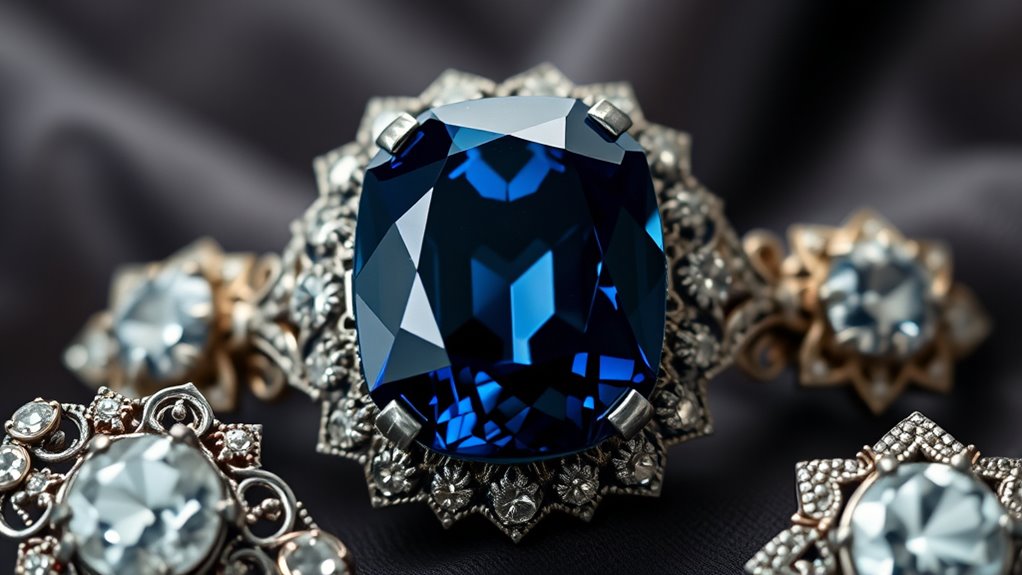
Have you ever wondered what makes the Hope Diamond so legendary? This stunning blue diamond, weighing 45.52 carats, is a true icon in jewelry history. Its mesmerizing blue hues come from trace boron, setting it apart as one of the most famous blue diamonds ever. Originally owned by royalty, including King Louis XIV, the Hope Diamond’s storied past is filled with tales of wealth and tragedy, fueling its reputation as a cursed gemstone. Today, it’s housed at the Smithsonian Institution, where millions admire its mystery and beauty. As a piece of legendary jewelry, the Hope Diamond continues to fascinate, blending centuries of history, royalty, and allure into one enthralling blue gemstone that’s truly timeless. To ensure the preservation of such priceless pieces, proper security measures are essential for safeguarding valuable jewelry. Understanding the importance of proper preservation techniques can help maintain its integrity over time, especially considering the value of rare gemstones that make these pieces so unique. Additionally, implementing advanced climate control systems is crucial to prevent damage from environmental factors.
Queen Victoria’s Mourning Jewelry: Elegance in Tragedy

Queen Victoria’s mourning jewelry transformed grief into timeless elegance, setting a powerful trend during the Victorian era. After Prince Albert’s death, she popularized mourning jewelry as a way to honor his memory. Victorian jewelry often featured jet, a black organic gemstone, prized for its deep color and lightweight feel. You might find pieces with locks of hair, preserved in lockets and brooches, serving as intimate reminders of loved ones. Symbols of mourning like crosses, skulls, and urns reflected themes of mortality and remembrance, making these pieces both personal and poignant. Today, Victorian mourning jewelry is highly collectible, valued for its craftsmanship and emotional significance. Queen Victoria’s influence made mourning jewelry a lasting symbol of love, loss, and elegant remembrance. The use of color accuracy in these pieces contributed to their striking visual impact and emotional resonance.
The Flamboyant Art Deco Cartier Tutti Frutti Collection
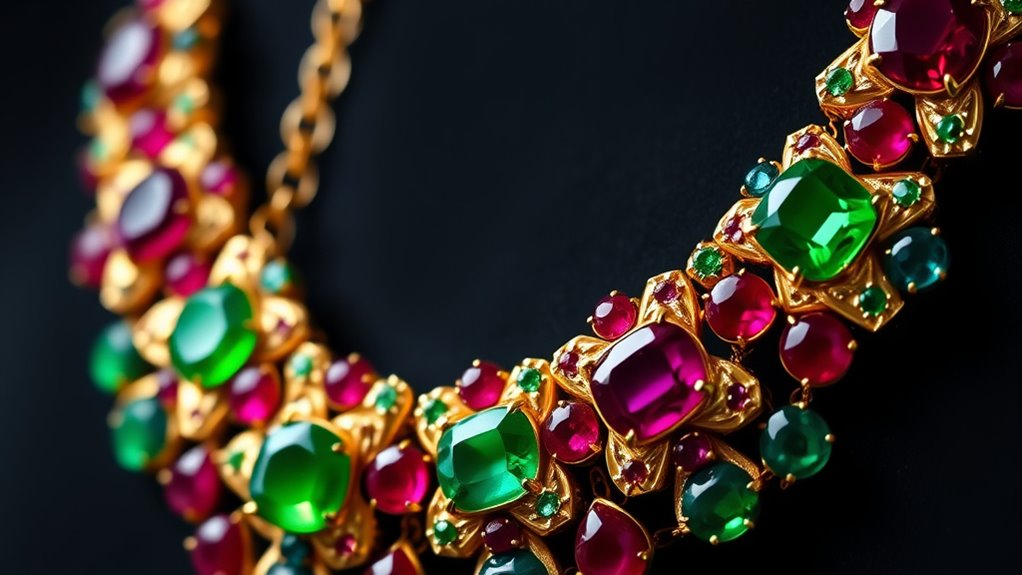
The Cartier Tutti Frutti collection of the 1920s exemplifies the bold, vibrant spirit of the Art Deco era through its inventive use of multi-colored gemstones. You’ll notice how Cartier combines rubies, emeralds, sapphires, and diamonds to create striking, exotic motifs that stand out in vintage jewelry. The collection’s designs feature geometric shapes fused with motifs inspired by Indian and Middle Eastern art, reflecting Cartier’s fascination with global influences. These pieces often include bangles, brooches, and earrings with symmetrical, contrasting patterns that emphasize vivid color and intricate craftsmanship. Cartier’s mastery in gemstone cutting and setting made these jewelry pieces durable and luxurious, defining an era of artistic innovation and making the Tutti Frutti collection a timeless symbol of Art Deco flamboyance. Additionally, the use of regional influences in the designs highlights Cartier’s appreciation for diverse cultural artistry. The bold combination of colors and motifs was also made possible by advances in gemstone cutting techniques, which allowed for more intricate and durable designs. The collection’s enduring appeal is further enhanced by its ability to blend luxury and artistry, setting a standard for jewelry design that continues to inspire collectors today.
Marilyn Monroe’s Iconic Pearl Necklace: Hollywood Glamour
Marilyn Monroe’s unforgettable style often centered around elegant pearl jewelry that captured Hollywood’s glamour and sophistication. Her signature look included a stunning pearl necklace, which became an iconic symbol of classic Hollywood and timeless beauty. For her 1953 birthday celebration, she wore a remarkable strand of 50 pearl necklaces, creating a visual masterpiece of Hollywood glamour. Valued at over $1 million and gifted by her then-husband Joe DiMaggio, this jewelry piece exemplifies luxury accessories that defined an era. Monroe’s image in the pearls remains one of the most enduring symbols of celebrity style and iconic jewelry. This necklace not only elevated her glamorous persona but also set a standard for opulence and elegance in the world of classic Hollywood.
The Royal Scepter and Crown Jewels: Symbols of Sovereignty
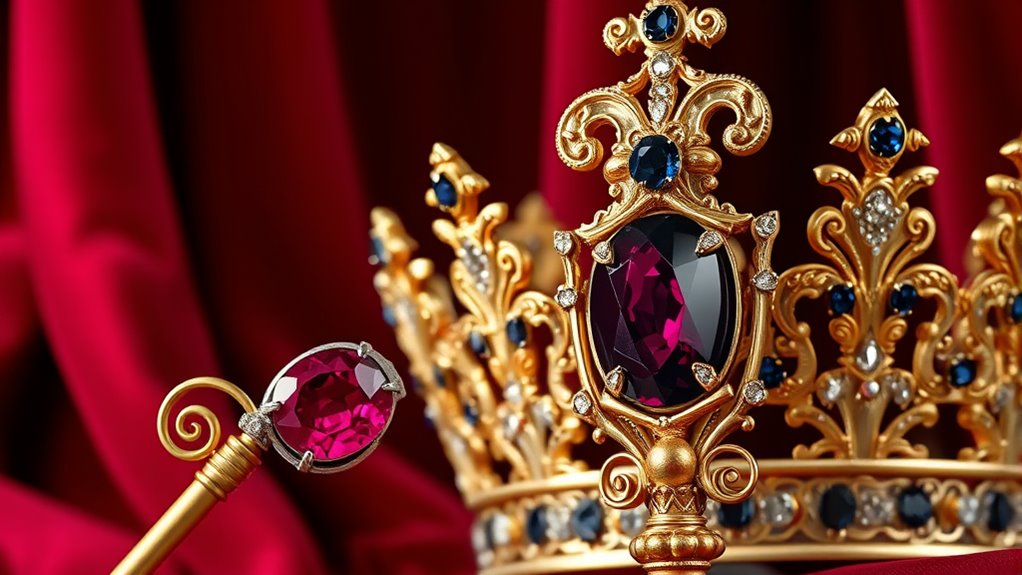
Royal scepters and crown jewels serve as powerful symbols of sovereignty, embodying authority and tradition that have persisted for centuries. The Crown Jewels, part of the royal regalia, include ceremonial jewelry like the Imperial State Crown, which features over 2,800 diamonds, including the Cullinan Diamond. The Sceptre with the Cross contains the 317.4-carat Cullinan I diamond, known as the Great Star of Africa. These pieces often incorporate historic gemstones such as the Stuart Sapphire and Black Prince’s Ruby, each with a legendary past. They symbolize divine right, royal authority, and the continuity of monarchy. Cultural Heritage plays a vital role in preserving the significance of these regal artifacts across generations. Maintaining the tradition of royal symbolism helps reinforce the enduring power and prestige associated with monarchy. Additionally, understanding the spiritual energy connected to these symbols can deepen appreciation for their cultural importance, as they often embody the spiritual and historical values of the nation.
Frequently Asked Questions
How Did Jewelry Styles Influence Societal Status Throughout History?
Jewelry styles have long been a symbol of societal status, and you can see this through history. When you wear luxurious pieces, it signals wealth and power, making you stand out. Different eras favored specific styles that reflected social hierarchies, like ornate Victorian jewelry or bold Art Deco designs. By choosing certain jewelry, you communicate your social standing, influence, and even cultural identity, shaping how society perceives you.
What Materials Were Most Popular in Different Jewelry Eras?
Imagine holding history in your hands—each era’s jewelry tells a story through its materials. In ancient Egypt, gold was king, symbolizing eternity and divine power. During the Renaissance, pearls and gemstones like emeralds and rubies dazzled, reflecting wealth and status. The Victorian era favored intricate gold and silver designs, often adorned with cameos. You can see how material choices echoed societal values and aspirations across time, shaping perceptions of beauty and power.
How Do Jewelry Designs Reflect Cultural Values and Beliefs?
Jewelry designs mirror cultural values and beliefs by showcasing symbols, motifs, and materials that hold specific significance. You notice how certain designs emphasize status, spirituality, or tradition, reflecting what a society values most. For example, intricate religious symbols express faith, while luxurious gemstones demonstrate wealth. By wearing particular styles, you communicate shared identity, beliefs, and social hierarchy, allowing jewelry to serve as a visual language of cultural expression.
Why Do Certain Jewelry Pieces Become Symbols of Historical Movements?
You might think jewelry is just decoration, but it often becomes a symbol of larger movements because it embodies the ideals and struggles of its time. When a piece captures the spirit of change or resistance, it transforms into a powerful statement. By wearing or recognizing such jewelry, you connect with history’s pivotal moments, turning personal adornment into a visual language that speaks of hope, rebellion, or unity.
How Has Technology Impacted Jewelry Craftsmanship Over Time?
You see how technology has revolutionized jewelry craftsmanship by enabling precision and innovation. With tools like CAD software, you can design intricate pieces that were once impossible, and 3D printing makes prototypes faster and more affordable. Modern techniques also allow for better gemstone cutting and setting, ensuring higher quality and durability. Overall, technology empowers you to create unique, detailed jewelry that reflects current trends while maintaining craftsmanship excellence.
Conclusion
So, next time you see a stunning jewel, remember, these pieces didn’t just sparkle—they defined entire eras and changed history. From royal crowns to Hollywood glam, each piece holds stories more legendary than you can imagine. You’re holding more than jewelry—you’re holding the essence of timeless power, elegance, and drama. These masterpieces aren’t just accessories; they’re the heartbeat of history, shining brighter than the stars themselves.
